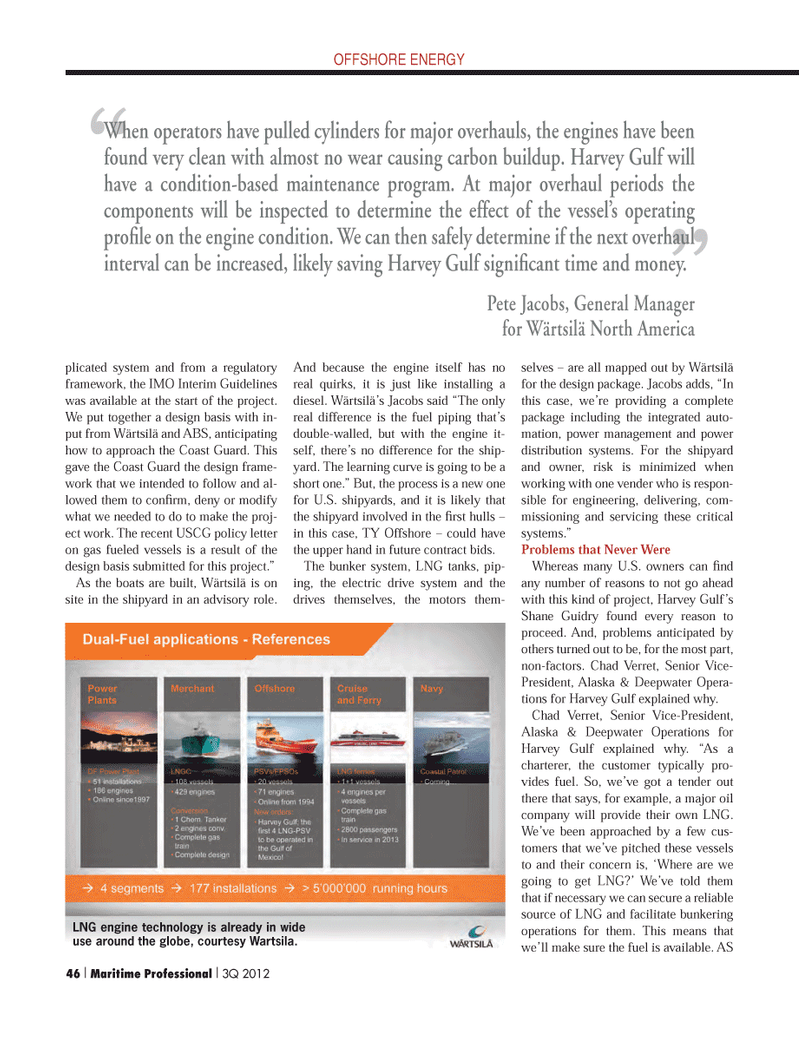
Page 46: of Maritime Logistics Professional Magazine (Q3 2012)
Classification Societies, Quality & Design
Read this page in Pdf, Flash or Html5 edition of Q3 2012 Maritime Logistics Professional Magazine
plicated system and from a regulatory framework, the IMO Interim Guidelines was available at the start of the project. We put together a design basis with in- put from Wärtsilä and ABS, anticipating how to approach the Coast Guard. This gave the Coast Guard the design frame- work that we intended to follow and al- lowed them to con rm, deny or modify what we needed to do to make the proj- ect work. The recent USCG policy letter on gas fueled vessels is a result of the design basis submitted for this project.? As the boats are built, Wärtsilä is on site in the shipyard in an advisory role. And because the engine itself has no real quirks, it is just like installing a diesel. Wärtsilä?s Jacobs said ?The only real difference is the fuel piping that?s double-walled, but with the engine it- self, there?s no difference for the ship- yard. The learning curve is going to be a short one.? But, the process is a new one for U.S. shipyards, and it is likely that the shipyard involved in the rst hulls ? in this case, TY Offshore ? could have the upper hand in future contract bids. The bunker system, LNG tanks, pip- ing, the electric drive system and the drives themselves, the motors them- selves ? are all mapped out by Wärtsilä for the design package. Jacobs adds, ?In this case, we?re providing a complete package including the integrated auto- mation, power management and power distribution systems. For the shipyard and owner, risk is minimized when working with one vender who is respon- sible for engineering, delivering, com- missioning and servicing these critical systems.? Problems that Never Were Whereas many U.S. owners can nd any number of reasons to not go ahead with this kind of project, Harvey Gulf?s Shane Guidry found every reason to proceed. And, problems anticipated by others turned out to be, for the most part, non-factors. Chad Verret, Senior Vice- President, Alaska & Deepwater Opera- tions for Harvey Gulf explained why. Chad Verret, Senior Vice-President, Alaska & Deepwater Operations for Harvey Gulf explained why. ?As a charterer, the customer typically pro- vides fuel. So, we?ve got a tender out there that says, for example, a major oil company will provide their own LNG. We?ve been approached by a few cus- tomers that we?ve pitched these vessels to and their concern is, ?Where are we going to get LNG?? We?ve told them that if necessary we can secure a reliable source of LNG and facilitate bunkering operations for them. This means that we?ll make sure the fuel is available. AS OFFSHORE ENERGYLNG engine technology is already in wide use around the globe, courtesy Wartsila. ??When operators have pulled cylinders for major overhauls, the engines have been found very clean with almost no wear causing carbon buildup. Harvey Gulf will have a condition-based maintenance program. At major overhaul periods the components will be inspected to determine the effect of the vessel?s operating pro le on the engine condition. We can then safely determine if the next overhaul interval can be increased, likely saving Harvey Gulf signi cant time and money. Pete Jacobs, General Manager for Wärtsilä North America 46 I Maritime Professional I 3Q 2012

 45
45

 47
47
